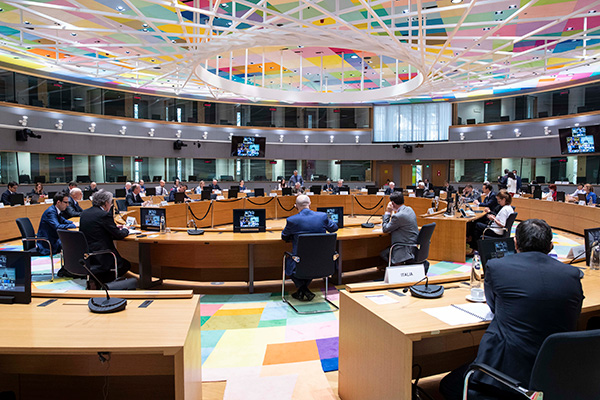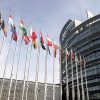Theme1
Europe’s neighbourhood in the Middle East and North Africa is set to become even more instable. Are Europeans capable of securing their own southern flank?
Summary
Europe’s strategy for its southern flank is patchy, its military presence is limited and its US ally appears to be withdrawing. Europeans need an overall security strategy for the region, one that they can implement with their own resources, but that is ambitious enough to prevent threats to their security. The way forward is an ‘indirect approach’ to achieve limited ends.
Analysis
As Sir Halford Mackinder wrote in The Geographical Pivot of History (1904): ‘A vast belt of almost uninhabited, because practically rainless, land extends as the Sahara completely across Northern Africa into Arabia. Central and Southern Africa were almost as completely severed from Europe and Asia throughout the greater part of history as were the Americas and Australia. In fact, the southern boundary of Europe was and is the Sahara rather than the Mediterranean.’
The EU does not have an overarching strategy for the security of its southern neighbourhood in the Middle East and North Africa. Or, rather, it does not have a strategy that can be implemented today. The 2016 Global Strategy sets five priorities, including ‘state and societal resilience to our east and south’. That is a broad objective; according to the Global Strategy, resilience means everything from sustainable development, human rights and democracy, to security. More importantly, it is an objective that can be pursued in a region that is at peace –but the Middle East and North Africa are at war–.
NATO does not have an overall strategy for the region either. The main focus of the Alliance is naturally the east, where forces are deployed on its borders to deter Russia. The alliance is present in the south (with a training mission in Iraq since 2018) because Donald Trump wanted to see evidence of its contribution to the fight against terrorism, and the allies were anxious to appease a President who had made his scepticism of NATO widely known. There was no military need for NATO to deploy, since the Global Coalition had been fighting ISIS in Iraq (and Syria) already since 2014. Nor was there any strategic consideration: the Coalition had in fact consciously avoided the NATO label in order to present itself as a truly international, rather than as a merely western, effort.
Individual European states, meanwhile, pursue their national interests in specific countries of the region, often to the detriment of a common approach.
Patchwork and piecemeal
The result is a patchwork of objectives and a piecemeal approach to military operations in the region.
The EU does have a comprehensive regional strategy for the Sahel, centred on Mali. The backbone of its military dimension is a 5,000-strong French operation: Barkhane. The Union as such has deployed a military training mission and two civilian capacity-building missions (one in Niger) to train the internal security forces, and there are 15,000 UN peacekeepers in operation MINUSMA. Effective cooperation between these various operations is limited. In spite of all these efforts, the security situation has been deteriorating rather than improving.
There is no European strategy for Libya. The EU supports the UN-recognised Government of National Accord in Tripoli, but France has supported its contender, General Haftar. Russia and Turkey have filled the void left by the absence of an effective European strategy. The EU has tried to wrest back the diplomatic initiative, but for lack of engagement with the military dimension its leverage remains limited. Meanwhile, the civil war goes on.
Europeans have but elements of strategy for the Middle East (and the Gulf). They seek to destroy ISIS, for which purpose the EU and all its member states have joined the Coalition (and the European allies accepted the NATO mission in Iraq). On this they are fully aligned with the US. The other EU objective is to prevent Iran from acquiring nuclear weapons. This has led to a clash with the US, which has withdrawn from the nuclear deal that the EU considered to have achieved that objective. For the US, this is part of a regional strategy that supports Saudi Arabia in its rivalry with Iran. The EU does not have a regional strategy: there is no view of a desired regional order, nor even of a desired political end-state in Syria. Meanwhile, fighting continues in several countries.
The EU and NATO have also deployed maritime operations in respectively the central and eastern Mediterranean. The current EU operation, Irini, has as its main task to implement the arms embargo against Libya, but it also contributes to the fight against human trafficking. NATO operation Sea Guardian focuses on maritime situational awareness. Neither operation has any significant impact on the region’s security situation.
Strategic choices must be made
The picture that emerges is very blurred: not even the geographic scope of European strategy is clear, let alone the precise ends. In view of the rising number of people that have tried to move to Europe ever since the wars in Libya and Syria started, many in Europe have come to see the Mediterranean as the border –and some want that border (and the land border in South-Eastern Europe) closed–. Others feel the need to engage militarily in the Middle East and North Africa, which they see as a forward line of defence, where security problems have to be contained so they do not affect Europe. Yet others seek to pursue much more ambitious objectives and aim to reform the states of the region, which the EU Global Strategy defines as stretching south down to Central Africa.
Unfortunately, the security situation in the region is much more likely to get worse rather than better as the COVID-19 pandemic interacts with the existing climate, economic, demographic and security challenges. The poor –both people and states– are getting poorer, while the rich hold their own. The struggle for scarce resources will intensify, weak states will lose even more leverage and support and subsidies from other powers that are hard-hit themselves will decrease. Growing instability in the Middle East and North Africa presents direct risks for the EU’s territory and for its connectivity with the world, far more than for any of the other global players such as the US, China and Russia.
The US, in fact, has been disengaging from conflict resolution and crisis management in the region. While close to 50,000 troops remain in permanent bases in the Middle East, Trump has withdrawn forces from operations in Syria and Iraq (and Afghanistan), and is considering withdrawals from the Sahel as well. In June 2020 he even announced a major reduction of US forces in Germany. Whether the latter will happen probably depends on the outcome of the US presidential elections in November. A Democratic victory might mean less unconditional support for Saudi Arabia, and perhaps a review of US policy on Iran, and on Israel (whereas Trump’s support for Israel’s annexation plans in the West Bank has created yet another transatlantic divide). But the main trend is likely to continue: regardless of who wins, the number-one priority of US strategy will be the rise of China; the appetite for military involvement in the Middle East and North Africa will certainly not grow, but probably diminish even further.
The conclusion is obvious: Europeans cannot rely on the US to secure their southern flank. Whether they act through the EU, NATO, ad hoc coalitions or alone, Europe’s states will have to look out for their own interests. Strategic choices have to be made.
The ends: limited but not easy
Europeans must settle on ends that can be achieved with the resources that they themselves can realistically commit yet that are sufficiently ambitious to safeguard their security interests. Withdrawing from the Middle East and North Africa and holding the line in the Mediterranean is not an option: the risk of negative spill-over effects of security crises is simply too great. Moreover, it is already the case that when Europeans and Americans move out, others move in. Europe cannot allow Russia, Turkey and the various Gulf states, or even China, to steer the policies of its southern neighbours in a direction that is detrimental to its interests. On the other hand, Europe has neither the means nor the leverage, nor even the legitimacy, to democratise and entirely remodel these countries.
Europe’s ends should therefore be limited. First, Europeans must help build a ring of states on Europe’s southern flank that provide sufficiently effective and inclusive government to appeal to their own broad population. That is a precondition for the second end: to build local security and defence forces that are able and willing to uphold an acceptable degree of internal security, in order to maintain that public support for the state. That, in turn, should ensure the ultimate end: to prevent the emergence of security problems that could threaten the European interest.
Such ends do demand a military presence in the region, which will likely be as good as permanent. But the Europeans could continue to pursue an ‘indirect approach’, very much like today: the main instrument should remain capacity-building and mentoring of the national security and defence forces, so that they can undertake autonomous military operations. If assistance in operations is necessary, the states of the region should be called on first. European forces should intervene directly and use force only if there is no other way of maintaining an acceptable degree of stability and preventing threats to Europe, as when France acted in Mali. Examples of ‘triggers’ are when a conflict threatens to spill over onto European territory, to cut off Europe’s connectivity, to generate terrorism against Europe or to generate migration to Europe on such a scale that only restoring peace can prevent it. The UN Security Council activating the Responsibility to Protect would be another example: the EU was instrumental in creating this mechanism and the Europeans must therefore contribute to its implementation –but the divisions between the permanent members make its use highly unlikely–.
The existing ‘indirect approach’ must be strengthened, however. First, Europe must be able to transfer weapons in addition to training troops. Troops cannot go into combat unarmed; if Europe cannot supply lethal equipment, states will turn to someone who will. Secondly, Europe should try and step up engagement with the senior levels of the security and defence forces, and with the political-strategic level. Capacity-building aimed at tactical and operational proficiency will have but limited effect if the partner state does not adopt an adequate strategy. This will always be a difficult balancing exercise, for the partner state must be in the lead. Yet more can be done, for example in terms of involving more senior officers, including generals and admirals, in staff courses, exercises and manoeuvres, both existing ones in Europe as well as specifically organised ones in the region.
Even these limited ends are not easy to achieve; they will require a much more concerted effort from the EU, NATO and their members than is the case today.
One strategy for the EU, NATO and their members
Europeans will likely continue to engage military with the region in different frameworks –NATO, the EU, coalitions of the willing or bilaterally– but there ought to be a single strategy for the security of the Middle East and North Africa that guides all military efforts. Given that any strategy must be comprehensive and include the political, economic, and security dimensions, and that, moreover, the US is unlikely to step up its efforts in the region, it would be natural for the EU to set the strategy. On 16 June 2020 the EU’s Defence Ministers agreed to develop a ‘Strategic Compass’: this could be an opportunity to reassess the threats and challenges, and to formulate a security strategy for Europe’s southern flank.
Ongoing operations in the various frameworks, in the Sahel, in Iraq and Syria, and in the Mediterranean, could then be reviewed, and reoriented and strengthened as required. If US forces leave the Sahel, Europe ought to be capable of sustaining its current efforts alone, but it must prepare for that scenario now. Europeans must also start thinking about their security and defence engagement in Iraq and Syria after the current Coalition winds-up its active operations, for that day will arrive. And Europeans must prepare an operation in Libya now: Europe must have a presence on the ground, in the form of a capacity-building mission, and forge close military relations with the government as soon as circumstances allow.
Given that the EU ought to set the strategy, and that Europeans will have to bear most of the burden of a continued ‘indirect approach’, it seems logical that any new capacity-building missions should be launched by the EU as such. If a crisis demands a larger-scale intervention, then the operational framework must be chosen that is best suited to the case at hand, depending also on the degree of US involvement and the needs of headquarters for command and control of operations. If the use of force is required, an ad hoc coalition or NATO remains the most likely option for now.
The ‘indirect approach’ too requires strategic enablers, as well as over-the-horizon reserves to extricate or reinforce a capacity-building mission if things go wrong. Pending the strengthening of the capabilities of the EU member states, these are two areas in which NATO could play a role, making arrangements involving non-EU allies to ensure the provision of enablers and the availability of reserve forces.
Conclusion
Thanks to NATO, Europe’s eastern flank is well in hand (for now), though, of course, the European allies must continue to increase their readiness and capabilities (ideally by progressively integrating their defence efforts through mechanisms such as Permanent Structured Cooperation). As the EU member states start to draft a ‘Strategic Compass’, they will soon realise that it is the southern flank that demands more urgent attention now, for Europe’s strategy is patchy, its military presence limited and its US ally appears to be leaving. The needle is pointing south.
Sven Biscop
Director of the Europe in the World Programme at the Egmont – Royal Institute for International Relations in Brussels, and a professor at Ghent University
1 The author warmly thanks the Belgian officers and his colleague Nina Wilén who were willing to share their insights, based on their experience in the field.
Video conference of EU Foreign Affairs Ministers (Defence) – June 2020. Photo: © European Union



